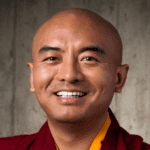In a single instant, the light of a lamp can illuminate
A house that has been dark and uninhabited for a thousand years.
Just so, realizing the luminous nature of your own mind for even an instant
Will purify an eon’s worth of negativity and obscurations.
—Shabkar Tsokdruk Rangdrol
The only difference between us and buddhas is that they recognize their true nature while we do not. The good news is that Mahayana Buddhism generally, and Vajrayana Buddhism specifically, offer us many effective methods for working directly with the mind to realize our buddhanature.
There are three main Tibetan traditions of meditation that work with the mind in this way. In Tibet, we refer to these as the chenpo sum, the “three great traditions”: the Great Seal (Mahamudra), the Great Perfection (Maha Ati or Dzogchen), and the Great Middle Way (Mahamadhyamaka). These traditions have different styles and methods, but their purpose is the same: to help us recognize the true nature of our own minds, which is to say, to directly experience our buddhanature.
Buddhas become buddhas because they recognize this true nature. We are suffering beings because we do not.
Generally, Vajrayana, or tantric, practice has two stages that help us recognize our true, awakened nature: the development stage and the completion stage. In my previous article in this series on Vajrayana practice, I shared an overview of development stage practice. This style of practice helps us transform our perception by imagining ourselves to be fully awakened buddhas. As we practice the development stage again and again, we slowly condition our mind to experience the world in a way that is closer to its true nature, as essentially pure.
But there is an even more direct way to discover our buddhanature. This form of meditation is “the best of the best” from the point of view of my lineage. It is the completion stage without concept, also known as the path of liberation. It is the swiftest and most profound path to realizing our true nature.
Here we are not using our imagination, we are not visualizing, and we are not using our intellect. Rather, we are working step-by-step with our mind directly.
At the heart of the path of liberation is the exploration of awareness. In meditation practices such as mindfulness, we focus our awareness on what we are thinking, what we are feeling, and what we are doing. But in the path of liberation practices we turn our awareness toward our awareness itself. We focus not on the objects of mind but on mind itself. We explore how our mind creates reality and how the mind is the root of everything that we experience.
At an appropriate point in our path, the Vajrayana teacher will directly point out to us the true nature of mind. This is known as “pointing-out instruction” and is given only to qualified students who have laid the ground to receive it through their meditation practice. To receive this instruction directly pointing out the true nature of mind is considered extremely fortunate. It is said to be the most precious, transformative teaching in Tibetan Buddhism.
Many of us may have glimpsed the nature of mind, on or off the meditation cushion. Perhaps we have experienced a moment of openness, or a groundless, ungraspable quality of mind that is at the same time radiant and luminous. However, it is likely we didn’t register the preciousness of this occurrence and missed the moment altogether. So the teachings we find in the completion stage without concepts specifically help us recognize the true nature of mind in those moments and gradually stabilize this recognition so we don’t lose touch with it.
So what is the true nature of mind? It is taught that mind has three qualities: the empty aspect, the clarity or luminous aspect, and the union aspect.
The first of these qualities is emptiness. In the Dzogchen tradition, this is referred to as the “empty essence.” Our body, our emotions, and our experiences seem so solid, but if we really examine them deeply, we find only a basic openness, a space out of which everything arises. That is what we mean by the term “empty essence.”
The path of liberation teachings help us to arrive at an initial understanding of emptiness, and then, through practice, to experience it. When we have direct experience of emptiness, we go beyond suffering. Not only are we freed from suffering, our basic goodness is unlocked and our potential enlightened qualities manifest.
The second quality of mind is its natural clarity, or “clear nature.” Here we are not talking about clarity as a light. We do not mean that the mind is luminous in the sense that it is shining like a bright light. It is luminous in the sense that it knows, it experiences. For example, when you are eating an apple, you “know” you are eating an apple. The part of you that knows this is the mind’s natural clarity.
Anything at all, whether it is thoughts or emotions or any appearance, can be seen or noticed by this clarity aspect of the mind. In fact, whether you think or do not think does not matter. Whether there are emotions or no emotions does not matter. Whether or not you have perceptions does not matter. The mind is always present in this luminosity, the knowing quality of awareness.
The third quality is that the emptiness and luminosity of mind are inseparable. This is what is meant when we say they are in union. This inseparable emptiness–luminosity is the basis for all perceptions, all appearances. All that we experience arises within this and out of this. Thoughts come and go, emotions come and go, experiences come and go, but all are manifestations of the mind’s nature of emptiness–luminosity.
These three qualities—the empty essence, the clear nature, and their union—are what we mean when we speak about our buddhanature. As I said earlier, buddhas become buddhas because they recognize this true nature. We are suffering beings because we do not.
When we do not recognize our true nature, we perceive dualistically. We do not see that the self is empty. We see the self as “something,” and that something becomes so sensitive, touchy, and grumpy. At the same time, whatever we see around us becomes a solid “other.” We do not see it as empty. Based on this dualistic perception of a solid self and other comes ignorance, aggression, and attachment, which are known as the three poisons. We do not see things as they truly are and so create endless suffering for ourselves and others.

Everything we have discussed up to this point concerns the “view” of the completion stage without concept—the way we see ourselves and our experience when we begin to recognize the empty clarity of pure awareness. So how do we practice this understanding?
In Mahamudra practice, we hear meditation instructions like, “Simply stay with however your mind is. Stay with a completely ordinary mind. You do not have to meditate. Be completely natural. Just don’t get lost.”
That is the Mahamudra style. Whatever state your mind is in, let it be in that state. If your mind is blissful, let it be blissful, but with awareness. If your mind is dull, let it be dull, but with awareness. If your mind is dull, do not try to make it alert.
That is not necessary. If your mind has a lot of busyness and thoughts, going here and there, let it go here and there, but be with awareness. The main thing is to not get lost because you do not have awareness. Do not meditate, but do not get lost.
In the Dzogchen tradition, first we look at the essence of all thoughts, emotions, and perceptions. What is the true nature of all these thoughts, emotions, and perceptions? We then rest in the nature of mind and continue to stay there. That is the meditation.
Having looked at the view of emptiness, clarity, and their union and how we practice this view, we move on to the third important part of our practice: application. This refers to how we apply the view and meditation in our everyday lives. In this tradition, the idea is simply to maintain the recognition of our true nature at all times through our day. We return to this recognition again and again, bringing it into everyday life while we are walking, talking, eating, and, especially, when experiencing negative emotions.
When I was young, I suffered from panic attacks. My teachers told me to simply let the panic be and instead explore the field of awareness through which I experienced it. This was different from what I had learned with shamatha meditation, which is more commonly known as mindfulness meditation these days. In shamatha, I would rest my awareness on an object, such as my breath or the feelings in my body, when I was having a panic attack. But in the Dzogchen teachings, I was taught, I did not need to do anything with my panic. I didn’t even need to pay attention to the panic, or divert my attention to something else.
Instead, I should recognize the essence of panic, which is pure awareness, then simply drop everything and be with that pure awareness.
This same approach can be applied to any experience or situation. For me, it was panic. Maybe for you it is stress, anxiety, depression, anger, or even positive experiences, such as joy and compassion. Whatever we experience, we can simply rest with the empty clarity of awareness itself. We can do this anytime and anywhere, whether we are in a meeting, walking, exercising, driving, or drinking tea. This is how we apply the practice in everyday life.
In the beginning, seeing our fundamental nature directly is quite difficult. Normally, before the recognition comes, we first have to practice shamatha meditation so our busy mind settles down and the mind becomes pliable and workable.
Once we have developed stability of mind, we can then look at the mind and examine it directly. This is known as vipashyana practice, or insight meditation. The point is not to think about these things conceptually but simply to launch an inner inquiry in which we look directly at our experience. When we recognize the nature of mind, vipashyana is nature of mind practice. We explore how the mind creates reality and how the mind is the root of everything.
When we have really gone deeply into experience, when we have really explored it deeply, then even one simple pointing-out instruction from the teacher can have a completely transformative impact on the mind. In the moment of recognition of our true nature, we realize who we are and always have been. We see our buddhanature at last.

